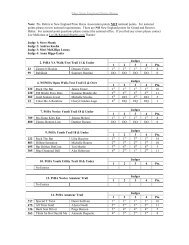2011 Official Rule Book - New England Pinto Horse Association
2011 Official Rule Book - New England Pinto Horse Association
2011 Official Rule Book - New England Pinto Horse Association
Create successful ePaper yourself
Turn your PDF publications into a flip-book with our unique Google optimized e-Paper software.
ClassEs<br />
and horse as well as harmony in all the movements and<br />
transitions.<br />
D. General <strong>Rule</strong>s<br />
1. No <strong>Pinto</strong> may be ridden more than once in any Dressage<br />
class.<br />
2. <strong>Pinto</strong>s may compete in no more than one recognized<br />
competition on the same day.<br />
3. <strong>Horse</strong>s are limited to a maximum of three (3) Dressage<br />
rides per day at Fourth level and below or two (2)<br />
Dressage rides per day above Fourth level. <strong>Horse</strong>s may<br />
enter no more than two (2) consecutive levels, Freestyle<br />
levels included, at any one (1) competition.<br />
4. Calling tests – Training through Fourth Level tests may<br />
be called during the competition except at any Final or<br />
Championship event at which time all tests must be ridden<br />
from memory.<br />
a. If a test is announced, it is the responsibility of the<br />
competitor to arrange for a person to announce the<br />
test.<br />
b. The announcing of the test must start with the first<br />
movement. Lateness and errors in announcing the ride<br />
will not relieve the rider from “error penalties”.<br />
c. Announcing the tests is limited to reading the<br />
movement as it is written once only. However, a<br />
movement can be re-read if there is reason to doubt<br />
that the rider heard the original call.<br />
E. Saddlery and Equipment<br />
1. Training through Fourth Levels<br />
An English type saddle with stirrups is mandatory.<br />
2. FEI Levels<br />
A Dressage saddle with stirrups is mandatory.<br />
3. Any Level<br />
a. Saddle pads should be white or of conservative color.<br />
b. The name and/or logo of an individual’s sponsors,<br />
breed logos, national flags, and business/farm logos<br />
may appear on a surface area not exceeding 200<br />
square cm on each side of the saddle cloth.<br />
c. A breastplate and/or crupper may be used.<br />
d. A cavesson noseband should not be so tight as to<br />
cause rubbing or irritation.<br />
e. Martingales, bit guards, tongue tied down, boots or<br />
bandages, blinkers, earplugs, and/or seat covers are<br />
prohibited.<br />
f. One whip no longer than 47.2” (120cm), including lash<br />
may be carried in all classes.<br />
g. Spurs must be made of metal, and there must be a<br />
shank either curved or straight pointing directly back<br />
from the center of the spur when on the rider’s boot.<br />
If the shank is curved, the spurs must be worn only<br />
with the shank directed downwards. (Exception: swan<br />
necked spurs are allowed.) The arms of the spur must<br />
be smooth. If rowels are used, they must be free to<br />
rotate.<br />
4. Bits and Bridles<br />
a. Any Level<br />
(1) All bits must be smooth and with a solid surface.<br />
The mouthpiece of a snaffle may be shaped in a<br />
slight curve. A bushing or coupling is permitted as<br />
the center link in a double jointed snaffle.<br />
(2) Bits must be made of metal, rigid plastic, or<br />
covered with rubber.<br />
(3) The diameter of the mouthpiece must be a<br />
minimum of 3/8 inch at rings or cheek.<br />
178 <strong>2011</strong> PtHA <strong>Rule</strong> <strong>Book</strong>



